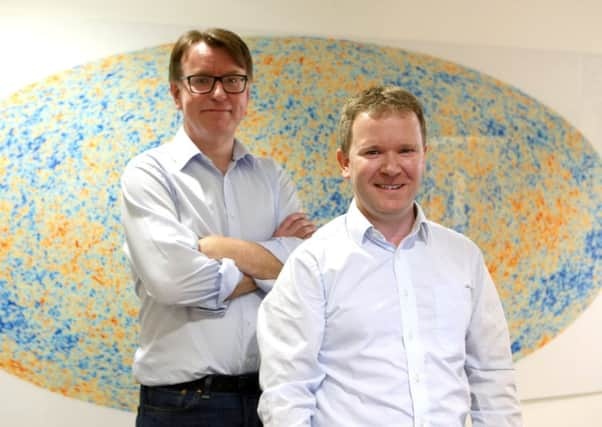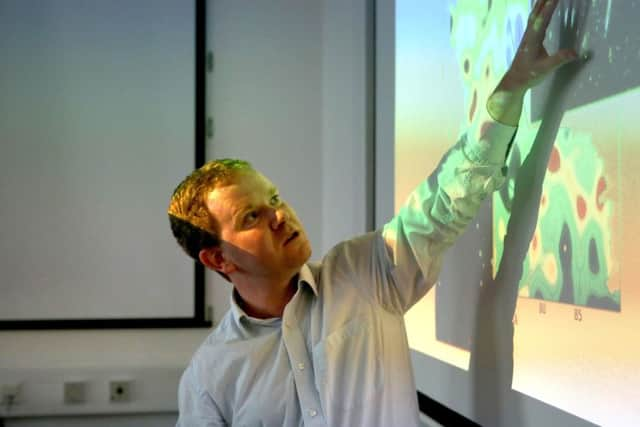LONG READ: Meet the Portsmouth astronomers mapping out the universe


Professor Bob Nichol and Dr David Bacon, from the Institute of Cosmology and Gravitation, have played key roles in the Dark Energy Survey (DES).
Kick-started in 2003, the project has united more than 400 scientists from institutions in the United States, the United Kingdom, Brazil, Spain, Germany, Switzerland and Australia.
Advertisement
Hide AdAdvertisement
Hide AdAnd together, with internationally-sourced government and university funding, this crack team has built and used a 570-megapixel digital camera to carry out a deep probe of 5,000 square degrees – or one eighth – of the southern sky.


Mounted on the Blanco four-metre telescope at Cerro Tololo Inter-American Observatory, high in the Chilean Andes, this supercamera has given the DES squad the scope to see 300million galaxies – each made of hundreds of billions of stars.
In turn, by stitching together images from the so-called DECam to form a ‘digital sky’, available to navigate online, participants can examine the properties of each of these galaxies – learning about their positions and patterns – and the mysterious force that allows them all to exist and multiply, dark energy.
With the survey now in its final year, we are learning more about our universe than ever before – and Prof Nichol was part of the pioneering team to be thanked for getting it off the ground.
Advertisement
Hide AdAdvertisement
Hide AdA self-confessed ‘elder statesman’ of the DES, he says: ‘Around the turn of the century, astronomers had a eureka moment when they discovered the growth of the universe wasn’t slowing down, it was speeding up – and we now know that was all because of this dark matter.


‘At that very vibrant time, American scientists put together a proposal they were taking to the US government for funding to start this DES and find out more about it.
‘Realising having two countries involved would be better than one, we put forward a proposal in tandem with them here and managed to get £2m from the UK government back in 2004.’
With the DES wheels then in motion, Prof Nichol swiftly teamed up with senior figures at the University of Portsmouth (UoP) to fork out £100,000 for one of the five optical filters that would go on to be used in the DECam.
Advertisement
Hide AdAdvertisement
Hide AdThis, he says, put UoP in a pole position for the future of the scheme as a whole.
‘We were one of the first institutions to realise how important it was not just to be at the table for this survey, but to be leading it,’ he explained
‘We were more nimble than universities like UCL, Oxford – and some of the big American ones – and a decade later we are reaping the benefits of that.
‘That speaks volumes of the institute here at UoP, and I am not ashamed to say we are as good as Oxford and Cambridge in this sort of science because of those investments.’
Advertisement
Hide AdAdvertisement
Hide AdYears down the line – with the DES well and truly under way – it was Dr Bacon’s turn to play a crucial role in its operation.
He leads the groups responsible for putting together the dark matter maps from the DECam’s pictures, working with and instructing colleagues in the US and PhD students in the UK.
With his digital sky now publicly available on the internet – detailing the first three years worth of DES findings, with another due to be released later this year – Dr Bacon has played a role in putting together the aesthetic spoils of years of hard work.
He says: ‘I’m incredibly proud. It’s been very widely-received among professional astronomers and cosmologists.
Advertisement
Hide AdAdvertisement
Hide Ad‘I’m always pleased when I go to a different institution and they have read these papers very carefully.
‘They don’t always agree with them, or they like to challenge them, but that’s all the fun of science.’
The first major DES release includes information on more than 400m astronomical objects, including distant galaxies billions of lightyears away, as well as stars inside our own.
Among this, participating scientists have discovered a dozen new stellar streams – which are remnants of smaller galaxies torn apart and devoured by our Milky Way.
Advertisement
Hide AdAdvertisement
Hide AdSurrounded by a massive halo of dark matter, the Milky Way exerts a powerful gravitational pull on these nearby galaxies – in turn growing by getting close to and pulling these systems apart and absorbing them,
And while the first mass of DES data is already yielding discoveries like this, Dr Bacon and Prof Nichol say there are bound to be countless others – many by young astronomers and even enthusiastic members of the public who will enjoy trawling through and dissecting the information themselves.
Prof Nichol, who has great experience in releasing data – having worked on the would-be precursor to the DES, the Sloan Digital Sky Survey (SDSS) – explained: ‘With Sloan, I don’t think we ever truly envisaged how far the public would engage with our images – they’re now the pictures you’ll find in products like Google Sky and Galaxy Zoo.
‘By releasing that data, people – and I’m even talking about people sat in their bedrooms – started spotting things and giving us information we never could have expected to find if we kept it to ourselves.
Advertisement
Hide AdAdvertisement
Hide Ad‘I have no doubt whatsoever that same, valuable two-way relationship will work in our favour with the DES.’
To learn more about the Dark Energy Survey, track its final-year progress or explore the data from its first public release in January, visit darkenergysurvey.org/dr1-data-release-papers/.
n You can also learn more about Bob and David by visiting icg.port.ac.uk.